by Paul Tomlinson
Harry Harrison was born 12th March 1925 in Stamford, Connecticut, where he spent the first two years of his life. His family then moved to Brooklyn, and then to another borough of New York City, Queens, where Harrison grew up and went to school.
"By an accident of time and space I was born in the New England state of Connecticut and grew up in New York City," he wrote in 1975. "My mother was from Russia and my paternal grandmother from Ireland, so it is easy enough to visualise a hiccup in time that might have had me in the Russian army, rather than the American one, or planting spuds for a living."
Harrison's mother Ria (nee Kirjassoff) was born in Riga, Latvia, then part of the USSR. "My mother went to the States when she was, I think, fifteen years old. She was a school teacher until she married."
His father was Henry Leo Dempsey: he changed his name to Harrison soon after Harry was born. "My father was born in New York State, up on Oneida. He was a very witty man, with a real Irish sense of humour - his mother was born in Ireland - and I would say that my sense of humour came from my father. He was a printer all his life: he was a very good printer, a top technologist, and he used to teach printing."
The Harrisons moved several times whilst Harry was young: it was the time of the Depression and mass unemployment - "My father worked a day or two a month, no more, in the printing trade" - and they had to keep one step ahead of their creditors:
"We'd do midnight flits: rent a new apartment, get a month's concession, pay for one month, stay for the two months, then for a third and owe the rent. The ice man would come with his horse and cart, and move the whole house into another apartment. We moved so often I really had no friends as a kid, and I did pretty rotten at school - or rather, I did well at things I enjoyed: I got the highest marks in class for Science and English, and the lowest marks in Spanish.
"I wasn't interested in writing very much when I was young, I was more of an artist. I did write and draw for the school magazine, sort of half and half. I won an art competition when I was in grade school, for 'Save the Animal Week' or something - I drew a squirrel saying 'We want more nuts!'"
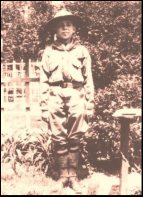
Harry Harrison aged 6
Being an only child, and solitary by nature, Harrison preferred to spend his free time reading pulp magazines: war titles, air war, railroad stories, Doc Savage, Operator 5, The Spider, and - best of all - science fiction. He supplemented these with armfuls of books each week from the Queens Borough Public Library, with C.S. Forrester and John Buchan being mentioned as favourites.
Harrison recalled the pleasure of discovering science fiction, something he once referred to as 'catching the rapture,' in the introduction to Worlds of Wonder: "Science fiction is great stuff when you are young, and has an impact not unlike the one received when putting the finger into a live electric light socket. Though for the most part I have only the vaguest of childhood memories, I do have one clear and sharp memory - that of reading my first science fiction story. The ancient cathedral-roofed radio, the sun in the window, the very texture of the carpet on which I lay, are all as clear as yesterday. My father gave me a copy of the old large-sized Amazing Stories, which appeared even larger in my seven-year-old hands, until it became a very bed-sheet of a magazine. I plunged into those rocket ship filled, time machine, ancient alien, strange invention stuffed pages and emerged with my whole life changed. For the better, I sincerely hope, but changed it was indeed."
Further recollections of his childhood days were included in his introduction to Philip Nowlan's novel Armageddon 2419AD:
"Woolworths did a good line of Buck Rogers devices, everything from small lead space ships to stamped steel rocket guns. Mine broke instantly after purchase and I can't remember if it clacked, popped or emitted a suction dart. The space helmet I had was more functional. It was made of some sort of fabric finished to look and feel like tan mouse fur and resembled a World War I flying helmet in most ways. It had an eye visor, broken off rather quickly, and stamped tin earphones. There was also a little vent on top whose function was never explained. I did love these future artefacts."
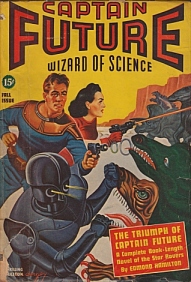
Captain Future - Fall 1940
Harrison's interest in science fiction led him into fandom at the age of 13: in November 1938 he became one of the 14 founding members of the Queens chapter of the Science Fiction League. The league had been launched by editor Hugo Gernsback as a way of promoting science fiction. Harrison wrote a letter to Captain Future magazine, which was published under the heading 'Favors Time-Travelling' in the Fall 1940 issue. And his drawing of a robot was published in the May 1941 issue of the fanzine Sun Spots.
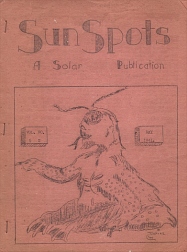
Sun Spots - May 1941
Graduating from Forest Hills High School in 1943, Harrison's was what he calls the 'no hope' class: it being the middle of the war, they faced immediate conscription at age 18.
Harrison wanted to join the Air Corps - "I didn't really want to drown, so I stayed out of the navy; I didn't want to be shot, so I stayed out of the infantry; I'd always like 'planes..." But wasn't flying 'planes equally dangerous? "In those days in the Air Corps there was something like 35 men on the ground for one in the air: I've always worn glasses, so I wouldn't fly - I became ground crew."
To ensure his place in the Air Corps, Harrison spent the weeks before he was drafted attending the Eastern Aircraft Instrument School in New Jersey, a government-approved repair station where he became a certified aircraft instrument mechanic: "Of course, I never saw an aircraft instrument again!"
Harrison was drafted into the U.S. Army Air Corps, and sent to Lowry Field in Denver, Colorado: "I had a good mechanical aptitude - in fact, the best mark I ever had in my life. They had general aptitude tests in the U.S. Army, one for IQ and one for mechanical aptitude: I scored 136 out of a maximum 160, which meant I ended up at the technical school, repairing gunsight computers."
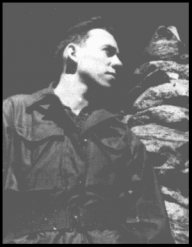
Harry Harrison in the Army
At Lowry Field, Harrison was trained as a power-operated and computing-gunsight specialist, where he learned computer theory and how to use and repair the Sperry Mark 1, the secret computer behind the Norden Bomb Sight: "Of course, I never saw a computer again when I left this school!"
In 1944 Harrison was sent to the Air Corps base in Laredo, Texas, where gunners were trained to fire computer-targeted fifty-calibre machine guns. His job, originally, was to keep the Sperry computer in working order, but he rapidly found himself responsible for a variety of tasks, including acting as armourer, truck driver - "I couldn't drive: I almost turned it over before I got a licence!" - and gunnery instructor "teaching kids to shoot machine guns." As a result of his skills with guns he was awarded the Sharpshooter medal.
It was during his time in the army that Harrison became interested in the 'universal language' Esperanto: "I attended a lecture and got a little book from the speaker: Learn Esperanto in 17 Easy Lessons. It was so boring in the army that I learned to read and write Esperanto to keep my mind alive."
During the Winter of 1945, Harrison was transferred to another gunnery school in Panama City, Florida, and when this closed he was transferred to Military Police duties and promoted to sergeant. His job was to literally 'ride shotgun' - with a loaded repeating shotgun - on a garbage truck, guarding half-a-dozen black prisoners who went around the camp collecting the garbage and taking it out to the dump. He had no trouble from his charges - they were all serving out a year for insubordination or some such, and just wanted to finish their time, get an honourable discharge, and get on with their lives. Unlike the other MPs who were "red necks from the South," Harrison got to know the prisoners and drank with them in the black serviceman's bar and ate in their mess hall, where the food was better: "The head chef was the salad chef from the Waldorf Astoria in New York City. Fantastic food!"
Harry Harrison was discharged in February 1946: his time in the army is not a period of his life he remembers fondly: "Did I enjoy my stint in the army? No. If you read Bill, the Galactic Hero you’ll see how I feel about the army. What effect did it have on me? Well, you hate the military for ever and ever and ever!"
In an introduction to Bill, the Galactic Hero in 2000, Harrison made his views about the army plain: "The mixture of sadism, unquestioned authority, brutality, racism, intolerance, vulgarity, to name but a few, was the antithesis of everything that I believed in ... The better you are as a soldier, the worse you are as a human being. Unthinking obedience, rote learning, intolerance to others, nasty death to the enemy, vulgarity and alcoholism - dope now substituted for drink in the new Army - the individual sublimated to the mass mind."
Like many who left the army after the war, Harrison had difficulty readjusting to civilian life, and spent several months trying to figure out what he wanted to do: "After I came out of the army, I was very upset - everyone was upset by being in the army during the war - and I needed some money, so I worked an hydraulic press for two or three days, stamping out sides of pliers: boringest job in the whole world! I kept one of those things I'd stamped out hanging from the light over my drawing board later. Whenever I got tired of drawing, I'd look at that and go back to drawing with great impetus!"
In the Fall term, Harrison began an art course at Hunter College in New York City, where he became a student of noted American painter John Blomshield. Harrison left the class, but continued to study privately under Blomshield for two years. At the same time, he attended the Cartoonists and Illustrators School, taking advantage of the G.I. Bill of Rights. Burne Hogarth – "the fellow who drew Tarzan" – was Harrison's first instructor, and he met many artists who were to become well-known in the comics field, including Wallace Wood.
"In art school I teamed up with Wally Wood, and you'll see a lot of old comics signed Harrison-Wood, and that's the Harrison and that's the Wood. Wally and I worked together for years, we started in school, selling our stuff, and goodness knows which magazines we worked for: there were 650 titles a month in those days, things like Captain Rocket and Rangeland Romances.
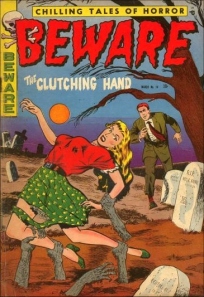
Beware - Cover by Harry Harrison
"We had a little studio. Wally and I worked there; Roy Krenkle was our assistant - he did a snazzy background for one panel on each page and erased the pencils. Al Williamson used to work in that studio a little bit. We used to have a nude model once a week and draw the nude. Frank Frazetta came round, other artists. We were in the middle of Manhattan, so we could all meet there.”
The Harrison-Wood partnership lasted for something like three years, during which time they drew hundreds of pages of comics, most of which were unremarkable except for their joint efforts for EC comics.
"I did other things besides comics: advertising illustrations, magazine illustrations. I illustrated Galaxy. I illustrated Marvel Stories…"
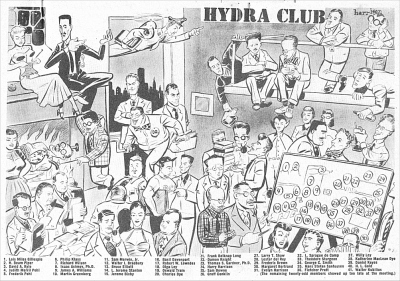
The Hydra Club - Artwork by Harry Harrison
His work on science fiction magazines gained him membership of the Hydra Club, which was attended by science fiction professionals including Isaac Asimov, Fredric Brown, Theodore Sturgeon, Lester del Rey, L. Sprague de Camp, Horace Gold and numerous others. Harrison was 'Harry the Artist', and another Hydra Club member, Damon Knight, commissioned him to illustrate the magazine Worlds Beyond.
"I was doing small illustrations for Worlds Beyond, but I got ‘flu and an infected throat, and I couldn’t draw." Harrison moved from the drawing board to the typewriter, where a shaky hand would have no appreciable effect, and wrote a short story which he called 'I Walk Through Rocks.'
"I typed a story out and asked Damon what to do with it, and he bought it for $100. My agent then was Fred Pohl, and Fred anthologised it, and I got another $100. So I did very well with my first story: I haven't done that well with a single story since, I'll tell you!" The story appeared as 'Rock Diver' in the February 1951 issue of Worlds Beyond.
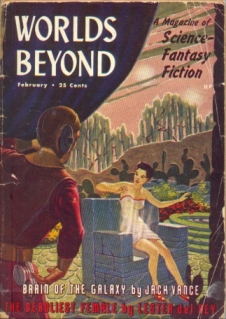
Worlds Beyond - February 1951
Around this time in New York, Harrison met Joan Merkler: "She was a dress-designer and ballet dancer. I was sharing a studio with a jewellery designer, and she was a friend of his." Harry and Joan were married in June 1954. "She gave up her career to take care of me and the kids, I guess."
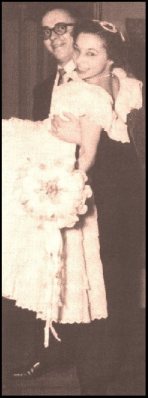
Harry & Joan Harrison - June 1954
Despite his initial success, Harrison's move from 'Harry the Artist' to 'Harry the Writer' was to be a gradual one. In the early 1950s, Harrison moved from being an illustrator into 'packaging' comic books: "Wally and I had broken up, and I was editing comics, publishing them, writing some of the scripts." He was responsible for three titles a month, one romance, Girls' Love Stories, one horror, Beware, and one humour, an imitation Mad magazine called Nuts. For each he usually drew the cover and produced a two-page filler, and in the case of the romance comic he also wrote a letters page offering advice for romance seekers which he signed 'Barbara Miles'.
But the comics boom came to a sudden end in the mid-fifties, when an investigation by Congress decided that comics were corrupting the nation's youth - this was the time of Dr. Frederick Wertham's highly influential book Seduction of the Innocent. The Comics Code was introduced in 1955.
"I was editing comics, and I naturally drifted into editing magazines," editing and packaging pulp magazines with such titles as Science Fiction Adventures, Fantasy Fiction, Rocket Stories, Sea Stories and Private Eye. Here too he often had to write some of the contents of the magazines. He also wrote 'true' adventure stories and some fiction for men's magazines: "I climbed Kilimanjaro with my Fingernails, I Went Down with My Ship, things like that. I did a lot of confession stories as well: My Iron Lung Baby, He Threw Acid in My Face, I Ate a Pigmy, interesting stuff like that!" During this period he also served as art director of Picture Week - "a little 10¢ magazine."
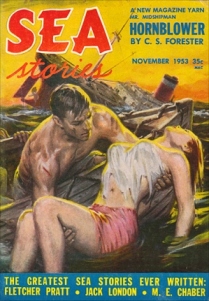
Sea Stories - November 1953
During the 1950s, Harrison continued to write short science fiction stories, using the knowledge he'd gained from discussions with writers in the Hydra Club. In 1956, having enough money saved, he quit work for life as a freelance writer:
"I wanted to start working on a book, a novel. I couldn't write very much in New York, tied down with various jobs, so I decided to go freelance again - I'd been freelance all the time with my art business. I went with my wife and year-old son, Todd, to Mexico." Why Mexico? "Because it is connected to America by road and you can drive there. I had a little Ford and about $250 saved up and a few articles to write. It was very cheap [in Mexico] in those days: a furnished house, full-time maid, all the food and everything was $100 a month.
"We had a lot of fun down there: we spent a year in Mexico in a small farm village, and liked it very much."
The Harrisons then returned briefly to New York in 1957 and from there caught the first 'fan' flight over to England, arranged to carry fans to the first World Science Fiction Convention to be held outside the United States.
"We lived in Bromley, Kent, in a residential hotel for a while: with my wife and baby in two rooms, all-in, twelve guineas a week. The food was impossibly bad. We went from there to a Pakistani boarding house, where my wife learned to cook curry from Pakistani friends.
"But these were the days of the killer smog - '57-'58 - and it was cold and miserable up in Camden Town. I got $500 doing one more confession and went off to Italy, to Capri. I had a friend there, Garry Davies (World Citizen number one) and knew people there who came down and met us, and we rented a little villa.
"Garry Davies' friend was Dan Barry, the artist who was drawing Flash Gordon. I knew Dan a little bit from New York, so I dropped him a note and said 'Dear Dan, I hear you need a writer for Flash Gordon, where else in Europe can you find an ex-comic artist who writes science fiction and would be ideal to write scripts for you?'
"Dan came down from France and joined us in Italy for a while, and I started working on the scripts. We worked together quite nicely."
It was a partnership which was to last for the best part of ten years, with Flash Gordon paying the bills while Harrison continued to work on other projects.
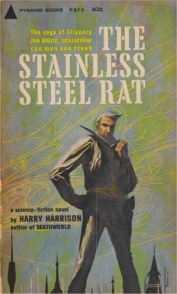
The Stainless
Steel Rat - Pyramid, 1961
In August 1957, in his seventh published short story, Harry Harrison introduced a character with whom he will forever be associated: James Bolivar 'Slippery Jim' diGriz, eponymous hero of 'The Stainless Steel Rat.'
"I was, at this point, working on my first novel, Deathworld: I'd started it in Mexico, worked on it a bit in England, worked on it in Italy. I lived in Italy for just about a year and then in October/ November 1958 had to go back to New York to get rid of my rotten agent who was cheating me. And my daughter, Moira, was about to be born, so we thought we'd better not be in Italy, so we went back to New York: the baby was born in January 1959.
"At about the same time I was staying with my in-laws, I'd sent John Campbell [editor of Astounding] about two-thirds of the novel Deathworld: he sent it back and said I ought to finish the whole book. I rushed and did finish the whole book and sent the manuscript. He sent me back - I thought it was a letter, but I opened it up and it was a cheque - a cheque for $2,100. And when you figure that my income for the previous year was $3,000, it looked pretty good!"
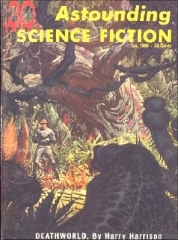
Deathworld in Astounding magazine
The first part of Deathworld appeared in the January 1960 issue of Astounding.
"I instantly bought four one-way tickets to Denmark. You might well ask, Why Denmark? All I can say is that in Mexico I heard a fellow talking French to Mexicans, trying to explain that his car was broken down. My French, at that time, was very bad, and I asked him if he spoke English: he was Danish and Danes all speak perfect English. And German. And French. But very little Spanish, so I translated for him, and he came with his wife and lived next to us for about a week.
"He was a very pleasant man, his name was Praben Zahle, and he was art director of a women's magazine, Tidens Kvinder (Today's Woman), and I wrote articles for him while in Italy - travel articles and cooking articles with my wife. I wrote to him in Copenhagen.
"I was shipping the car over to Denmark and we were just going to stay temporarily. It was the most gorgeous Summer - this was the Spring of 1959 - and it hadn't been that warm in 200 years. We thought it was the most gorgeous country in the world. Which it is.
"We stayed there for seven years. The kids went to school there, and after seven years were speaking more Danish than English, and we figured we'd either got to settle there for life, or get out. So we went to England for a year, but that wasn’t too satisfactory, so we went back to New York and then drove to California in the same old Volkswagen bus we’d bought in Copenhagen, which was fixed up as a camper. We figured if we were going to be in the States, we’d be where it is warm, so we bought a house in Southern California near San Diego and lived there God knows how many years - until the city of San Diego put a road through the house - cut the house in half!
"We took the money and came back to London. By this time the children were grown up: Todd was at university, and Moira was in high school; she wanted to stay in the boarding school she was in, so we came back to London to buy a home, but the deal fell though."
A trip to Ireland, "to just take a look at it," resulted in the Harrisons making it their permanent home for more than twenty years.
While based in San Diego, Harrison taught an elective course on science fiction at Montgomery High School, developing a textbook - A Science Fiction Reader (1973) - with Carol Pugner, chairman of the school's journalism department. He also taught an extension course on SF at San Diego State University, and with Willis E. McNelly put together the college text Science Fiction Novellas.
During the early years of his freelance writing career - as he himself admits - Harrison continued to write novels which conformed to the pattern he had established with Deathworld, and he became identified as a 'Campbell writer'. But he soon felt constrained by the limits this placed on his work: he was aware that he was working to a 'pulp formula' in his early novels, and that he was afraid of risking a change to this winning technique. Deathworld was followed by The Ethical Engineer (a.k.a Deathworld 2), and Sense of Obligation (a.k.a. Planet of the Damned) "...was a slightly disguised Deathworld."
Harrison wanted to branch out into more humorous fiction. With the Stainless Steel Rat stories he was adding humour to the adventure, but there it was a case of sneaking it in. The Technicolor Time Machine was a more sustained attempt at humorous adventure, yet still in the ASF tradition.
Harrison had begun work on an experimental novel as early as 1959, provisionally titled If You Can Read This, You're Too Damn Close, and it was written with the knowledge that Campbell would never publish it. "All of my experimentation so far had been in the short story, since the time investment there is obviously much less than the novel ... At that period a novel a year was the most I could do and the thought of losing a year's book income was not to be considered."
Not that Harrison was in any way blaming Campbell for this situation. Harrison's respect for the editor is well known, as reflected in the oft-quoted comment: "When I was fifteen years old I thought John W. Campbell was God." Harrison wrote this in the introduction for the collection of Campbell editorials which he edited. Harrison has also written of Campbell: "... he took a crude form of pulp fiction and forced it, and its practitioners, to grow up, to face the realities of science and its impact upon the world, and in doing so invented science fiction as we know it today."
In truth, Harrison was constrained to some extent by his own opinion of his abilities, regarding himself, during his early career, as 'the most unliterary of writers,' as a result, at least in part, of a high school education in the 1940s where literary appreciation was not a strong subject.
"... thinking myself an 'unliterary' person I took a long time to write anything other than beginning, middle, end, action-moved, plot-supported, sexless, hardcore science fiction."
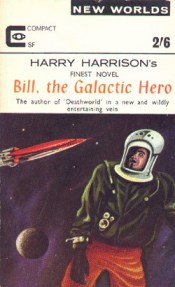
Bill, the Galactic Hero in New Worlds magazine
His experimental novel, Bill, the Galactic Hero, finally saw print in 1965 in New Worlds, and it marked the beginning of a new phase in Harrison's career. Sensitive novels dealing with serious science fiction themes - Make Room! Make Room!, Captive Universe, and In Our Hands, the Stars, soon followed.
Harrison's desire for a more 'literary' approach to science fiction was something he shared with English writer Brian W. Aldiss. Sam J. Lundwall wrote of their common interest: "Harry Harrison and Brian W. Aldiss had long been concerned by the fact that while SF had no limits to its scientific and technological explorations it was, to say the least, a form of writing of almost uniformly indifferent literary quality. In an attempt to draw attention to this situation they founded the first little literary magazine to take a serious look at this field, SF Horizons. This journal had a brief and happy life, and it led the way for many others to follow."
Harrison and Aldiss believed, and stated in the first issue of their magazine, that "... what SF must have before all its potentials can be realised is a wide and flourishing literature of intelligent criticism."
Reflecting on this thirty-five years later, Harrison wrote of the 'Dawn of SF Criticism':
"The earliest SF criticism was very uncritical, in both fanzines and professional magazines. The motto was don't rock the boat: if it was SF it had to be good. But a lot of it wasn't - and at least one novel was very controversial. This was Robert A. Heinlein's Starship Trooper. It was dismissed as dismissed as fascist, racist, immoral, chauvinistic, militaristic. Among all this flying mud I read one piece by Brian W. Aldiss that was not a review but an honest to God piece of intelligent critical writing.
"Brian was literary editor of the Oxford Mail and writing reviews of all kinds of books. When he took on Starship Trooper he applied critical skills well honed outside of SF. He applied those standards to SF. We corresponded, grew enthusiastic, and eventually brought to fruition a small journal of SF criticism titled SF Horizons, which was first published in 1964."
During the 1960s and 70s Harrison and Aldiss collaborated on a series of science fiction anthologies, their attempt to draw attention to the best of what science fiction had to offer. Between 1968 and 1976 he and Aldiss edited nine annual volumes of Best SF. In his introduction to the first of these Best (stories from 1967) anthologies, Harrison said that in the early days, when he was a member of the Queens Science Fiction League, the motto was to 'Boost Science Fiction.' By 1968 it had been boosted:
"The time has therefore come to end the uncritical boostings and to select the good from the bad - and draw attention to the results." HH intended to apply the critical standards to SF which was applied to mainstream literature, as suggested by Kingsley Amis in New Maps of Hell (196?) James Blish provided the 'Credo' for the first volume - which basically called for the best SF to be good science and good fiction.
They also edited the Astounding-Analog Reader, a two-volume collection of stories which they felt were those which could still be regarded as fine examples of modern storytelling, rather than historical curiosities, an approach which didn't win universal approval from fans.
Beginning in 1969, Harrison also edited four volumes in the Nova series, for which he invited and / or commissioned new stories. "I shall not say that the science fiction magazines have taboos," he wrote in the first volume, "But they certainly do have editorial distinctness, and perhaps writers labour to subconscious taboos when they write for these markets. That the stories included here were to be printed first in book form seems to have had a freeing effect on the contributors' powers. Not that the stories are overly nasty or overly sexy - or overly anything. They are just - if just is the word - excellent stories by the best science fiction writers around ... I can truthfully say that with the more leisurely pace of the book editor, compared with the hectic monthly magazine deadlines, I have had the chance to read more, work harder, dig deeper. The results have been most heartening."
Harrison's interest in improving the general quality and reputation of science fiction led him to mock the excesses of the genre, most notably in Bill, the Galactic Hero, where he takes on Heinlein and Asimov; in the short story 'Space Rats of the CCC,' which was an attempt to show that space opera had had its day; and in Star Smashers of the Galaxy Rangers which parodies the novels of E.E. 'Doc' Smith.
During the 1960s Harrison also began researching his most ambitious novel to date, it concerned "... the dangers of overpopulation, over-consumption, pollution and allied problems."
Researched over a five year period, Make Room! Make Room! was set in the near future - "... just a few decades away, when the reader, and certainly the reader's children, would be around to see what the world would be like. But in setting a novel so close in time I had to extrapolate every detail of our lives and see that I had got it right. I also wanted to write a more realistic novel than I had ever attempted before."
Meticulous research, this time on collaboration with anthropologist Dr Leon Stover, also lay behind what might be seen as one of Harrison's least science fictional SF novels, Stonehenge. A detailed exploration of Britain and Europe during the building of Stonehenge, it sought to demonstrate that the monument had a political foundation rather than being a primitive astronomical computer.
Throughout the rest of his career, Harrison has drawn heavily on extensive scientific and historical research for the more serious of his SF novels - The West of Eden trilogy, The Turing Option, The Hammer and the Cross and most recently the Stars and Stripes trilogy - which alternate with the more light-hearted adventure stories. But even these latter have more about them than some of Harrison's critics allow.
Brian W. Aldiss in Trillion Year Spree states that the Stainless Steel Rat series "-hardly add to his reputation, popular as they are." He then goes on to quote a page and a half from The Stainless Steel Rat. The argument seems to be that because it is a humorous adventure story, then it can't have any intrinsic value beyond entertainment.
Fortunately not all critics feel the same way. Steven R. Carter, writing in the critical journal Extrapolation, says that the three novels collected in The Adventures of the Stainless Steel Rat, "-although delightful to read, might be dismissed as the literary equivalent of cotton candy if one failed to note the number of interfaces in them and the humanistic viewpoint developed from the interfaces..." Carter says that Harrison's "desire to entertain frequently interfaces with the desire to instruct" and that "The humanising interfaces in this series ... add a significant dimension to Harrison's novels that lifts them beyond the level of pulp writing."
Carter quotes Slippery Jim's attitude - "Cold-blooded killing is not my thing..." - and goes on to say:
"This statement goes to the heart of Harrison's philosophy as represented in various works since it offers a key to his ideas about the brutalising effects of war (as in Bill, the Galactic Hero), a key to the dangers of superstition and too great a respect for any type of authority (as in Captive Universe), and a key to the need for international co-operation to solve the worldwide problems of overpopulation, poverty, and dwindling resources (as in Make Room! Make Room! and Skyfall)."
Harrison outlined his approach to combining elements of adventure and humour with more serious themes in Twentieth Century Science Fiction Writers: "I have found that an action story with two or three levels of intellectual content below the surface enables me to say just what I want to say. I have also found that humour - and black humour - can carry ideas that can be expressed in no other way."
It's impossible to imagine the field of science fiction without Harry Harrison in it, and equally impossible to imagine Harry Harrison as anything other than a science fiction writer - what else could he have done? Various opportunities must have been offered over the years, and some must have been more tempting that others. Here's one which sought to combine the author's interest in overpopulation with his need to make a decent living, recalled by Harrison in 2001:
"I had a friend in London, he was a member of the Indian Communist Party. He said: Harry, you want to get rich? I said: Sure, I wouldn't mind that. He said: Bring contraceptives to India, open a rubber company called 'French Letters to India,' or something like this, and you'll get very rich because we need birth control there, and it's very important for the society. I said: Well, I have a lot of ambitions in my life, but I've never thought of that!"
In 2009, Harry Harrison's life-time of contributions to the field of science fiction were recognised by his peers, when the Science Fiction Writers of America presented him with the Damon Knight Science Fiction Grand Master award.
A more deserving recipient it is hard to imagine.
© Paul Tomlinson 2009